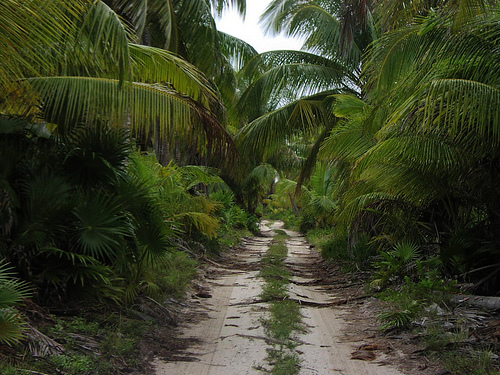

Sian Ka’an is a biosphere reserve in the state of Quintana Roo situated on the eastern shore of the Yucatan peninsula. Sian Ka’an Biosphere Reserve is designated as an UNESCO World Heritage Site due to its unique and rear wildlife. Sian Ka’an encompasses 526,000 hectares of tropical forest, savannah, mangroves as well as coral reefs in the lagoons down its coast. Besides its also has many cenotes (sinkholes) and 23 known Mayan ruins who settled first in the region. Some charges apply in some parts of Sian Ka’an biosphere. The best time to visit Sian Ka’an Biosphere Reserve the is probably from November till May. After rainy season that usually lasts from August to November the forest is blooming. Sian Ka'an occupies an area, which belong to the Quintana Roo municipalities of Felipe Carrillo Puerto and Tulum. The ejidos that border the biosphere are Pino Suárez, Chunyaxché, Felipe Carrillo Puerto, X-Hazil Sur and Andrés Quintana Roo.
The Sian Ka'an Biosphere Reserve (whose name in
Mayan means Gate of Heaven) is part of the geological province of
the Yucatan Peninsula, whose main feature is the flatness of its
relief and its surface is mainly made of stone limestone, which
prevents the formation of surface water currents and favors the
outcrop of wells known as cenotes in Mexico. Off the coast of Sian
Ka'an, in the Caribbean Sea, is a complex of coral reefs that
constitute the second largest of its kind, after the Great Barrier
Reef, east of the coast of Australia.
On the coast of this
Biosphere Reserve there are large white sand beaches, small bays and
mangroves, among other ecological systems. Each of these spaces
houses different types of fauna. The climate is warm subhumid, and
the rainy season occurs during the summer. Due to its location off
the Caribbean coast, Sian Ka'an is exposed to hurricanes that take
place in the Caribbean Sea between the months of June and November.
Due to the deficient natural drainage of the area, in the rainy
season a good part of its surface remains flooded in the summer. You
can find 4 types of mangroves that are the red mangrove, black
mangrove, white mangrove and gray mangrove.
Attractions
A
very peculiar ecosystem in the wetlands of Sian Ka'an is that of the
so-called petenes, a masses of trees that can measure up to thirty
meters high and that rise among the grass of the marshes. These
plant formations are almost unique in the world, because outside the
Yucatan peninsula, they exist only in the US state of Florida, where
they are known as hammocks, and in Cuba, where they are called cayos
de monte. They are mostly oval or circular in shape and their size
varies from a few tens of meters to almost two kilometers in
diameter. They are generated due to the presence of springs of fresh
water, which sprout in the middle of brackish water marshes and
allow black growth of large trees.
There are 23
archaeological sites in the reserve, including Muyil and Tampak,
among others.
Operation
In 1993, the reserve management
program was published, which includes various components to be
executed, as well as its rules of use and zoning. Among the main
components we can mention the conservation that includes inspection
and surveillance, prevention and combat of forest fires, as well as
ecological restoration. The one of sustainable social development
that includes the handling of natural resources; the one for public
use divided into local participation, archaeological and cultural
heritage, recreation and environmental education and promotion. As
well as the promotion of scientific research and administration.
The Reserve is administered by the federal government of Mexico
through the National Commission of Natural Protected Areas that
collaborates very closely with non-governmental organizations,
producer organizations, research institutions and private
initiative.
Rules and recommendations for your visit
Follow the instructions of the ANP staff and specialized guides.
Use telescopes or binoculars to avoid approaching wild animals.
Take photographs and never take home "memories" such as plants,
animals, corals or any other species of the place.
Do not collect
or damage flora and fauna.
Do not introduce animals or plants
outside the region.
Do not make noise in nesting areas of birds
or other species.
Do not wear clothing too bright colors.
Do
not feed wild animals
Do not throw objects or liquids in rivers,
lagoons or bodies of water.
Try to take the trash generated
during the visit, or deposit it in a place intended for it.
Use
only biodegradable sunscreens.
For no reason acquire plants or
animals in danger of extinction.
Use the marked trails.